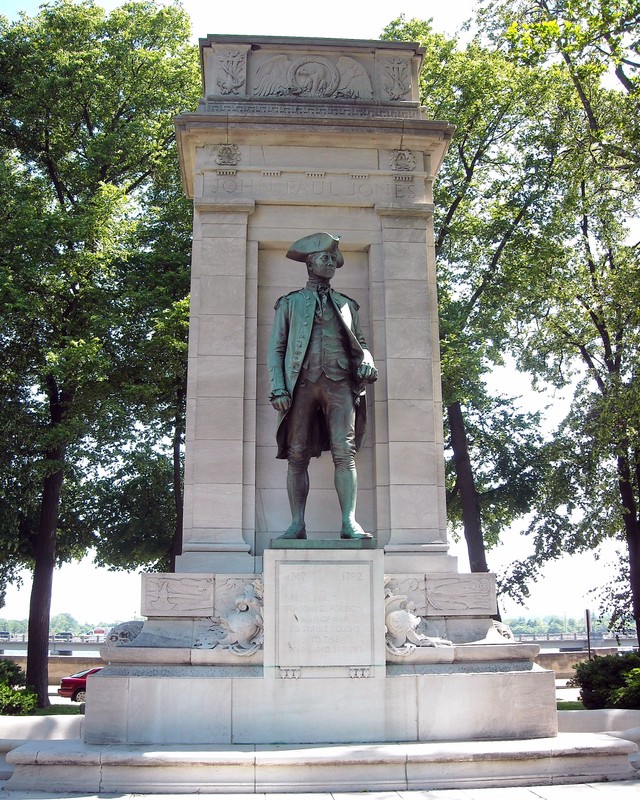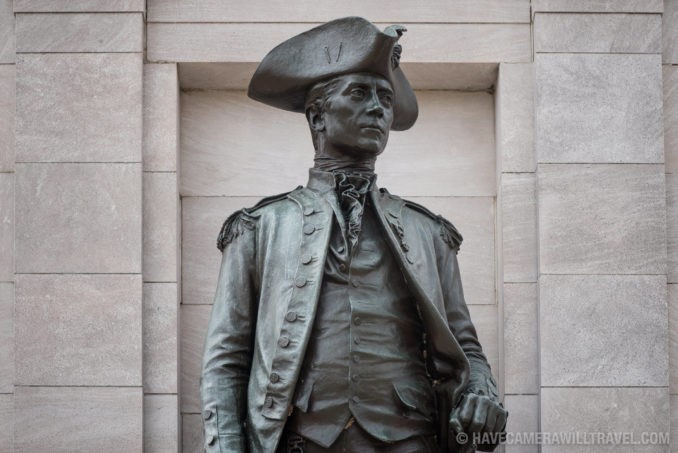John Paul Jones Memorial
Introduction
Text-to-speech Audio
Images
John Paul Jones Memorial in West Potomac Park

A closer look at the memorial's bronze statue

John Paul Jones (1747-1792)

Backstory and Context
Text-to-speech Audio
John Paul Jones was born John Paul on July 6, 1747 in Kirkcudbright, Scotland. At the age of twelve, he commenced an apprenticeship with a Scottish merchant shipper, during which time he sailed to the colony of Virginia and paid a visit to his elder brother in Fredericksburg. In the late 1760s, Paul worked as a chief mate on a transatlantic slave ship. After two years, he quit and returned to Scotland. In 1772, Paul sailed to the West Indies and purchased a ship. The following year, however, he killed the ringleader of a mutinous crew. In an effort to escape possible punishment, he fled the West Indies and changed his name by adding the surname Jones. A few years later, he settled in Fredericksburg.
When the American Revolution broke out in the spring of 1775, Jones traveled to Philadelphia. There, he received a commission as a lieutenant in the fledgling Continental Navy and was assigned to USS Alfred. The following year, Jones received a promotion to the rank of captain and assumed command of USS Providence. From August to October 1776, he sailed the Atlantic Ocean from Nova Scotia to Bermuda, capturing eight ships and sinking eight more in the process. In June 1777, Congress appointed Jones commander of a newly constructed vessel, USS Ranger. Operating in St. George’s Channel and the Irish Sea, he raided English coastal towns and captured HMS Drake. In August 1779, Jones took command of USS Bonhomme Richard, which served as the flagship of a small American squadron. The following month, in the North Sea off the coast of Yorkshire, the American ships encountered a merchant fleet escorted by HMS Countess of Scarborough and HMS Serapis. During the engagement that followed, known to historians as the Battle of Flamborough Head, the Bonhomme Richard caught fire and began to sink. In response to a British request to surrender, Jones defiantly replied, “I have not yet begun to fight!” After a three-and-a-half-hour gunfight, the British warships surrendered. For the victory, King Louis XVI of France awarded Jones a gold-hilted sword and made him a chevalier of France.
Following the war, Congress awarded Jones the Congressional Gold Medal for his service to the country in 1787. Soon after, he accepted an offer to serve as a rear admiral in the Russian navy. Miserable in the position, Jones resigned and settled in Paris in 1790. On July 8, 1792, he died at the age of forty-five and was buried in an unmarked grave. In 1905, his remains were discovered, exhumed, and brought to the United States. Eight years later, Jones’s remains were reburied in a tomb at the United States Naval Academy Chapel in Annapolis, Maryland.
In June 1909, Congress allocated $50,000 for the construction of a memorial in honor of Jones. Dedicated in West Potomac Park in 1912, the memorial consists of a bronze statue of the Scottish-born naval commander backed by an elaborate marble stele fountain. Designed by sculptor Charles Henry Niehaus, the statue depicts Jones, dressed in full military uniform, standing and gazing into the distance with his left hand resting on the hilt of his sword. Etched into the back of the marble stele is a relief of Jones raising an American flag aboard the Bonhomme Richard. At the stele’s ends, near its base, two stylized fish spout water into two small basins.
Sources
History.com Editors. "John Paul Jones sets sail." History. A&E Television Networks. 30 October 2020. Web. 5 February 2021 <https://www.history.com/this-day-in-history/john-paul-jones-sets-sail>.
"John Paul Jones." DC Memorialist. 29 October 2012. Web. 5 February 2021 <https://dcmemorialist.com/john-paul-jones/>. "John Paul Jones." Encyclopædia Britannica. Web. 5 February 2021 <https://www.britannica.com/biography/John-Paul-Jones-United-States-naval-officer>.
"John Paul Jones." Naval History and Heritage Command. United States Navy. Web. 5 February 2021 <https://www.history.navy.mil/browse-by-topic/people/historical-figures/john-paul-jones.html>.
"John Paul Jones Memorial." National Park Service. U.S. Department of the Interior. Web. 5 February 2021 <https://www.nps.gov/places/000/john-paul-jones-memorial.htm>.
https://en.wikipedia.org/wiki/John_Paul_Jones_Memorial
https://dcphotoguide.com/john-paul-jones-memorial/
https://www.britannica.com/biography/John-Paul-Jones-United-States-naval-officer
